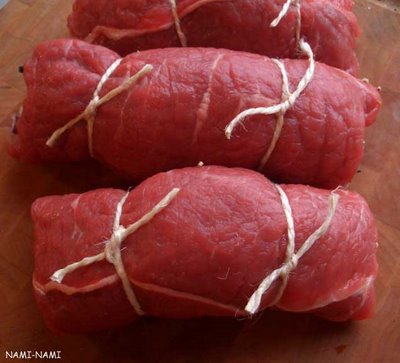Today (February 20, 2007) is vastlapäev or Shrove Tuesday again. All youthful Estonians are sledding down the hills tonight, eating copious amounts of bean or pea soup and maybe even some pig's trotters afterwards, followed by several fluffy cream-filled lenten buns. Not me, however. I'm skiing on the slopes of Italian Alps, checking out the restaurants in Valle d'Aosta and stuffing myself on Italian food. Life is good.
The post below originally appeared on March 1, 2006. I'm re-posting it to 1) mark the folk calendar occasion and 2) convince you to bake these. Believe me, these buns are perfect indeed!

Last night was supposed to be Shrove or Pancake Tuesday, but if you had visited any Nordic foodblogs, you'd realise that it wasn't Pancake Tuesday, but Bun Tuesday. There were buns all over the place. In Finland,
Pastanjauhantaa and
Axis of AEvil wrote about
laskiaspulla. In Sweden,
Dagmar,
Clivia and
Kinna blogged about
semlor. And every single Estonian had one
vastlakukkel - or two - during yesterday. Most schools would have included them in lunch, and many offices order trayfuls of lenten buns to savour during the day.
The Swedes have known the
semlor-buns since the late 1600s, back home in Estonia it's a more recent treat. The Estonian
vastlakukkel, Finnish
laskiaispulla, Swedish
semla, and Danish
fastelavnsbolle are pretty similar. Lenten buns are basically fluffy yeasted caramom-scented buns, where the dough is enriched with eggs and butter. In Estonia, they are served with whipped cream alone. The Swedes include almonds, the Finns either marzipan and/or jam. Some Swedes eat them in a bowl of milk (and then call it
hetvägg). Since learning that the Swedish King Adolf Fredrik died in 1771 after eating 14 of these
semlor-in-milk (after a subtantial multi-course meal), I'll keep having mine without milk..
Here is a recipe I've used to make my lenten buns for the last few years, adapted from an old Estonian cookbook.
Vastlakuklid: Estonian lenten buns
(
Hõrgud vastlakuklid)
Yields about 24
Buns:
500 ml lukewarm milk
50 grams fresh yeast
800 grams plain flour (soft), sifted
3 Tbsp sugar
1 tsp salt
1 tsp ground cardamom seeds
200 grams butter, melted and cooled
2 eggs, whisked
Filling:
500 ml whipping cream (35-38%)
2-3 Tbsp sugar
200 ml lingonberry jam (optional)
Take all the ingredients to the room temperature about an hour before starting.
First make the dough. Crumble the fresh yeast into a bowl and add the lukewarm milk little by little, stirring with a wooden spoon until the yeast has dissolved. Add the sugar and about half of the flour, stir with the spoon. The dough is rather wet at this point, so no need to use your hands.
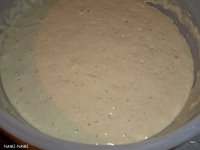
Cover the dough with a clean kitchen towel* and put in a warm place to prove. Make sure there is no draught in the kitchen! Let the dough double in size (about 30-45 minutes, depending on the kitchen conditions). It will look like the picture on the right, with small air bubbles on the surface.
When doubled in size, add the salt, cardamom, melted butter and whisked eggs. Stir in most of the flour and start kneading. You will have to knead the dough for about 10-15 minutes, until it's shiny and elastic and doesn't stick to the bowl anymore.
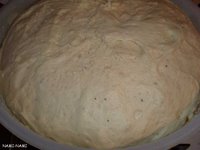
Now cover again with the kitchen towel and leave to double in size in a warm place. This should take about 45-60 minutes. Knock the dough back and leave to rise again. By this time the dough will look nice and all puffed up, quite dry in consistency.
After about half an hour you can start the rolling. Every cook probably has their own trick for making perfect buns. Here's what I do. I twist off a small piece of dough (about the size of a small to medium egg), put it onto a large piece of parchment paper, cupping my hand over the piece of dough. A bit like holding the mouse (the computer mouse, I mean), with fingers touching the working surface as well.
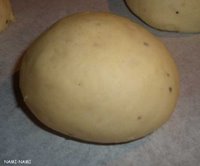
Then I start rolling "the mouse" on the table in small, firm circles. After about 10 seconds or so, you should end up with a beautiful and perfectly shaped ball under your cupped hand. Like this:

Transfer to a baking sheet. Let rise again for about 30 minutes.
Brush with milk or whisked egg (both are fine, the latter results in a shinier bun) and bake at 200-225˚C oven for about 15-20 minutes, until you have beautifully golden brown lenten buns.
[Just to recap: you pre-prove the dough, then add the rest of the ingredients and let the dough rise twice. Then you form the buns and let them rise a bit again. Then you bake:)]
Take out of the oven and cover with a kitchen towel to soften the tops. This is essential, as otherwise you'll make a mess when you start eating the cream-filled buns!
Make the filling. Whisk the cream with some sugar. I like to include some lingonberry jam in my cream filling, as this adds a nice tart touch to the otherwise very sweet bun.
Cut a small slice off the bun and fill with some cream. Put the "lid" back on.
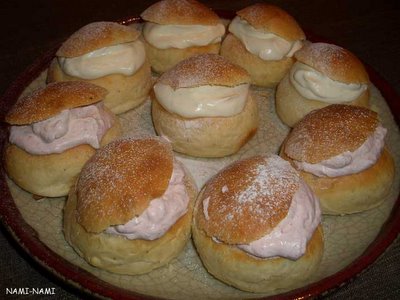
Serve. Especially delicious after a night out on a snowy hill.
* It's a good idea to cover the bowl loosely with a cling film first, so if the dough rises very high, you won't end up with a sticky kitchen towel.
 Burns Supper 2007 left me not only with lots of leftover leeks that I had bought for the cock a leekie soup and ended up using in a savoury leek souffle. I also had some neeps & tatties left over (that's boiled and mashed turnips and potatoes for those of you who don't speak Scots; neeps and tatties are the traditional accompaniments for haggis:) The best way to use up those vegetable mashes, obviously, is to make karelian pasties or karelian pies. Yep, you've seen these Finnish goodies on this blog before - here, served with eggy butter. Karelian pasties are small rye-crusted pastries (usually)with rice porridge or potato mash filling, although carrot, carrot & potato, turnip & potato, carrot & rice, barley porridge, etc fillings are available, too. I usually simply buy them from a local supermarket, but they aren't so difficult to make. The crust is simple and inexpensive flour and water affair, the filling is simple and inexpensive, too. Yet, the resulting pasties are nothing less than delicious, especially with eggy butter or simply buttered and eaten with a slice of savoury ham, for instance.
Burns Supper 2007 left me not only with lots of leftover leeks that I had bought for the cock a leekie soup and ended up using in a savoury leek souffle. I also had some neeps & tatties left over (that's boiled and mashed turnips and potatoes for those of you who don't speak Scots; neeps and tatties are the traditional accompaniments for haggis:) The best way to use up those vegetable mashes, obviously, is to make karelian pasties or karelian pies. Yep, you've seen these Finnish goodies on this blog before - here, served with eggy butter. Karelian pasties are small rye-crusted pastries (usually)with rice porridge or potato mash filling, although carrot, carrot & potato, turnip & potato, carrot & rice, barley porridge, etc fillings are available, too. I usually simply buy them from a local supermarket, but they aren't so difficult to make. The crust is simple and inexpensive flour and water affair, the filling is simple and inexpensive, too. Yet, the resulting pasties are nothing less than delicious, especially with eggy butter or simply buttered and eaten with a slice of savoury ham, for instance.






















